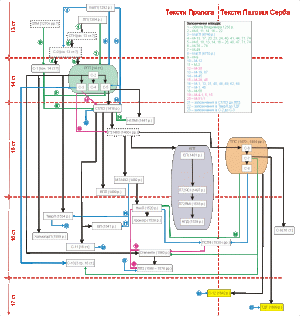General observations
Nicholas Zharkikh
Dependence of texts
Observations of the texts of the SMF can be summarized in the form of the following stemma, which turned out to be more complex and richer than imagined by the previous authors.
Stemma of SMF versions according to N. Zharkikh
It should be considered without haste and taking into account the following notations:
- vertical dotted red line divides all texts into two groups according to the structure of episodes: on the left – the structure of the Prologue, on the right – the structure of the TPS. Directly on the separate line placed PSLF and S-12, which do not belong to any of the groups and do not form a third structural group;
- horizontal dotted red lines divide the centuries marked on the left;
- rectangles with a dotted contour show hypothetical protographs;
- rectangles with a solid contour show the really known texts;
- rectangles with a white background show the manuscripts;
- rectangles with a yellow background show printed texts;
- rectangles with rounded corners and colored backgrounds cover groups of related texts;
- thick black lines with arrows indicate the borrowing of the bulk of the episodes; the same thick line from S-3 to S-10 had to be made blue so that there was no ambiguity when crossing thick lines;
- thin colored lines indicate the borrowing of a small number of episodes signed in a text block. The difference in the colors does not carry the content, made only to avoid doubt when crossing such lines;
- in the last three places (21 – 23) it was necessary to refuse to carry out connecting lines, marking only their beginning and end, as is done on complex radio circuits;
- captions in parentheses indicate certain dates (last event in the chronicle or date of printing);
- captions in square brackets indicate approximate dates.
The stemma does not show any other written sources, except the Laurentian and Hypatian Chronicles, because it turned out to be very complicated.
The stemma shows two shortcomings of previous studies:
1. Ignoring (superficial consideration) the chronicle texts of the SMF, which gave many new options and had an impact on later texts.
2. The eulogy by Leo Philologist was ignored, which was not only valuable in itself, but also influenced later texts.
Techniques for varying texts
Classification of texts
Regional variants
Sources for compiling "Tale"
The main sources for writing early versions of the SMF were the Laurentian and Hypatian chronicles, known in those parts where it was about the campaign of Batu and the death of Prince Michael.
This information was very sparse, and it is natural that the authors of the SMF disseminated it, on the one hand, borrowings from other hagiographic works, on the other – the fruits of their own imagination.
The significance of "Tale" as a historical source
From all this it follows that the SMF is not any historical source – only a monument of historiography and literature.
This is not surprising for hagiography: all, without exception, the lives of saints from the time of early Christianity were written several centuries after the death of their heroes and, like the SMF, reflect the realities and ideas of the time of writing, not the time when saints had lived.
Although not a century but decades passed from Michael’s death to the appearance of the SMF, this was enough to make the real details of the event partly forgotten and partly offset by the powerful influence of established hagiographic stamps.
Thus, the historiography researcher can trace on the basis of the SMF, how views on the events of Batu’s time have developed in the past – only the sequence of epithets attached to Batu may already be interesting.
A literary historian can trace the development of rhetoric and stylistics of ancient Great Russian literature on the basis of the SMF.
Finally, the historian of religious and political ideas, which changed from older versions of the SMF to later ones, can find some food here.
And only a pure historian of the events of the 13th century will not find any food here. Therefore, I warn such historians against using the SMF as a source, so as not to transfer to the 13th century realities and ideas of ancient hagiographers and / or later authors of 14 – 17 centuries.
Shortened text of the section. Full text in ukrainian version.

